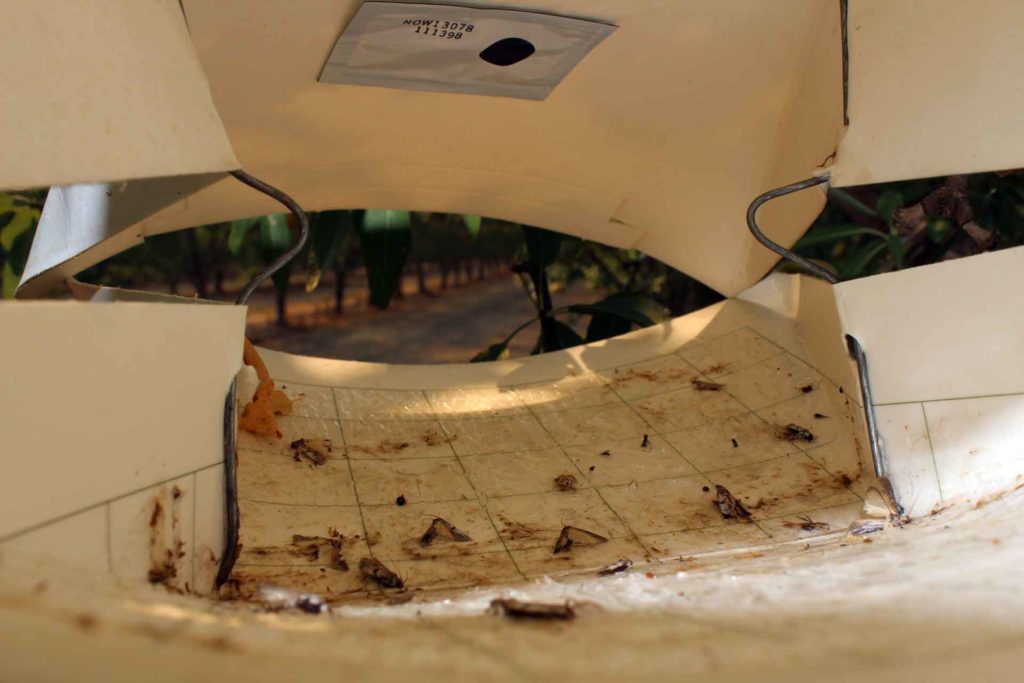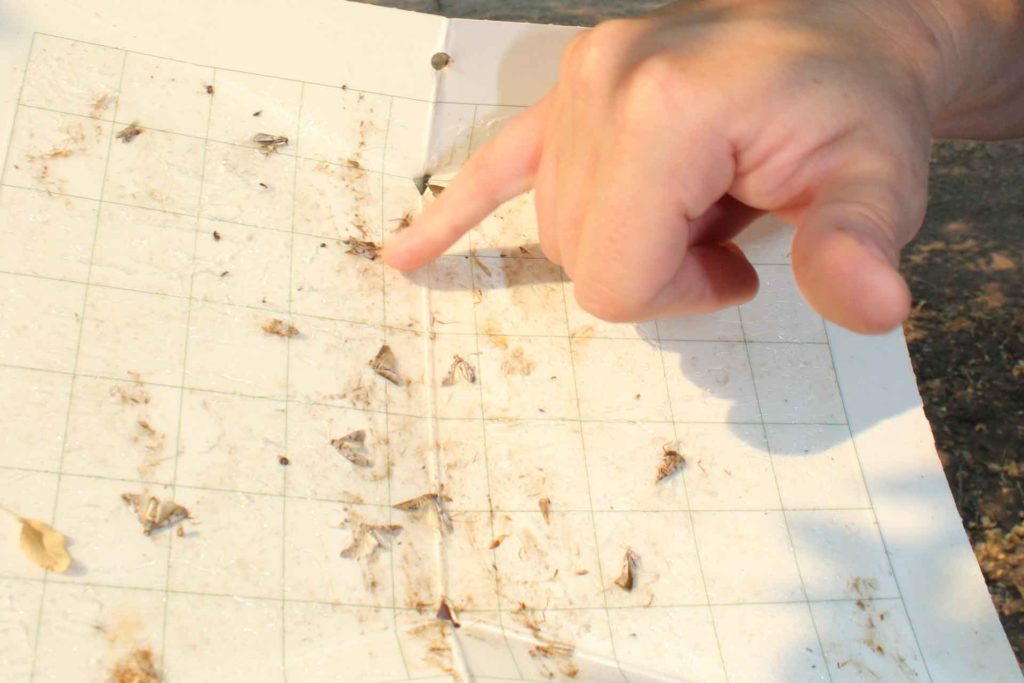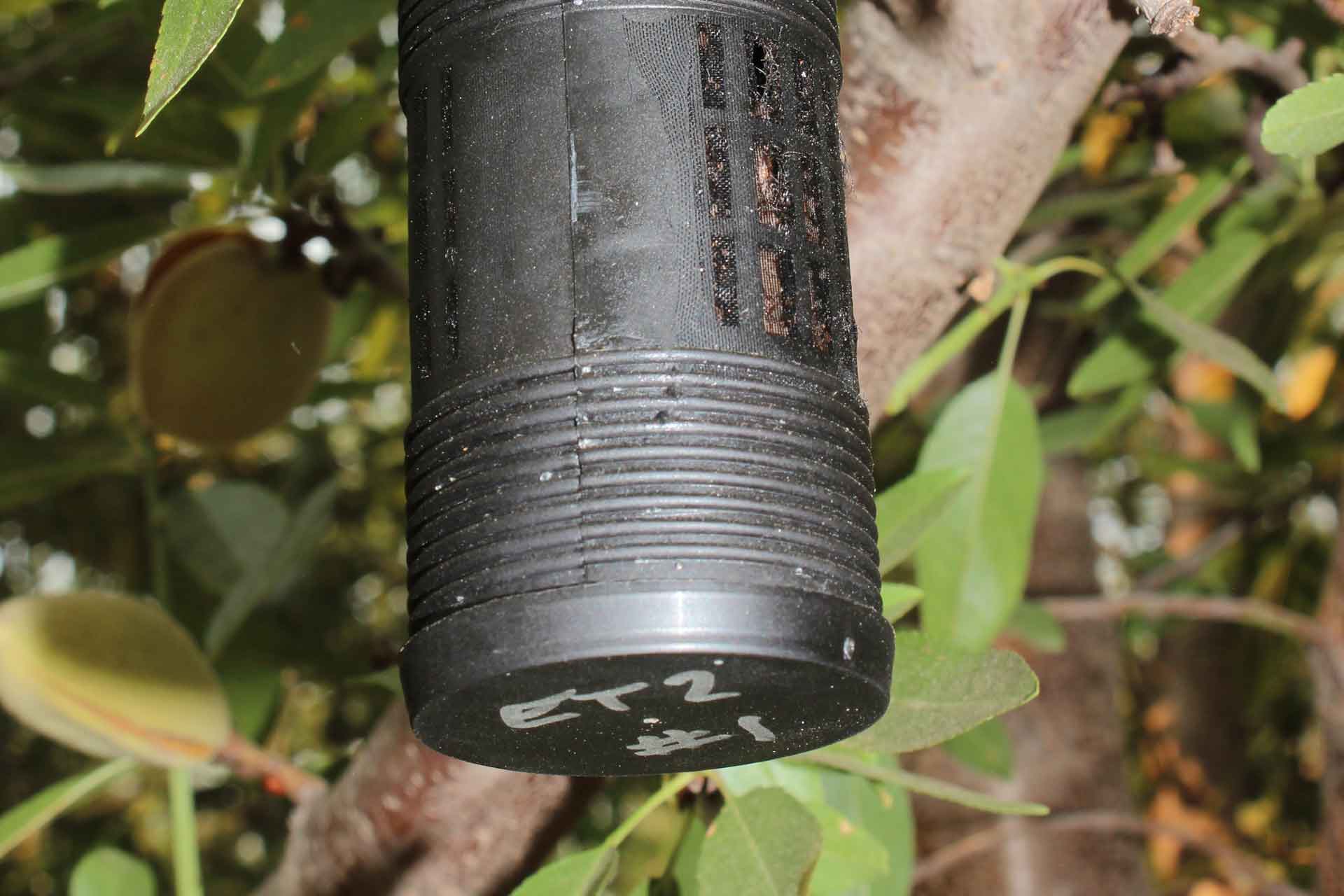First flight numbers of navel orangeworm (NOW) in the Sacramento Valley overall looked low to moderate in pheromone traps, but there are some exceptions to that, according to Emily Symmes, UC Cooperative Extension Area IPM advisor, Sacramento Valley.
The more severe winter could have kept first flight numbers down, Symmes continued, but also there was a more prolonged spring flight due to relatively cooler temperatures and numerous rain events, which may have appeared as lower overall abundance in NOW traps during the early flights.
“I don’t necessarily think this is a low pressure year from an overall perspective, especially now that we are seeing significant numbers in the third flight” Symmes said.
Third and fourth flights, if a fourth flight arrives, are always larger as a result of population build-up, and heat units increasing into the summer reduce the generation time, Symmes said.
Trapping
Many growers and pest control advisors (PCA) that were trapping solely with pheromone traps this year were not seeing a high abundance of moths in the traps in early flights, Symmes said.
Symmes’ egg traps had low counts during the first flight, too, and to a large degree the second flight as well, she said.
In comparison, the adult female traps (referred to as kairomone, bait bag, or Peterson traps) were hit pretty heavy all year long relative to recent years (even the high damage year in 2017).
The takeaway from this is, there can be a lot of variability among the different types of traps and obviously among different orchards as well based on location, landscape factors, and level of sanitation, Symmes said.
“Our UC guidelines primarily discuss using the pheromone traps and the egg traps,” Symmes said, and she recommends using more than one kind of trap, including the traps for adult females.
The benefit of using a variety of traps is that this method will provide more information to help determine the risk potential in a given orchard.
“The more information you can get, the better off you end up being at predicting how many sprays it’s going to take to get to one or two percent damage or below, and timing those sprays for best efficacy,” Symmes said.
Symmes recommends using all types of traps that are available in some combination.
How many traps do you need? That’s the 64,000 dollar question. One isn’t usually good enough, but 30 is obviously overkill, so it comes down to what is economically feasible and how many of which type of trap provide the information needed, Symmes said.
“What we do know with NOW, the pheromone traps tend to pull from a larger distance,” Symmes said, which means not as many are needed because they’re more attractive over a longer range.
“The female-based traps, whether it’s an egg trap or the Peterson style bait bag traps, tend to trap a little more locally,” Symmes said.
A typical trap set for Symmes is a pheromone trap, then no fewer than three of the Peterson traps, and four egg traps in a given block.
“Usually I’ll replicate that, depending on the block size, at least twice if the orchard is big enough,” Symmes said.
Symmes has stopped using egg traps in walnuts because there isn’t a degree day model to utilize with these traps, and they didn’t seem to work well, with very few eggs detected.
“In walnuts, I use a combination of pheromone traps and the Peterson bait bag traps,” Symmes said.
Doing visual inspections of mummy and in-season nuts throughout the year is another piece of information that growers can use to be prepared when the most damaging later flights of NOW arrive, Symmes said.

Mummy Surveys
Typically, Symmes runs her trap sets for NOW all the way into November, mostly out of a curiosity to see how long there is flight activity in the orchard and how abundant the moths are after harvests.
“With the pheromone traps, if you get a hot day in December or January, you can catch males. We don’t know if it means anything, so I would say after harvest in the late fall and winter, focus on doing your mummy survey and prioritizing sanitation efforts based on what you find,” Symmes said.
Determining how many mummies and the mummy infestation rate is a better use of time and money. “Based on what we know right now, I think that’s going to set you up for more information going into next year,” Symmes said.
Winter Sanitation
When should winter sanitation start?
Coming in with a sanitation shake too early could result in not getting as many of the mummies off, but waiting too long could end up with extensive rain, making it impossible to get into the orchard.
“There’s not a great recommended timing, and it just depends on the weather each year, how much acreage a grower has to sanitize, and other logistical and financial factors, so it’s hard to give an exact calendar date for every individual operation. The important message is to get in and clean the orchards as much as possible,” Symmes said.
Up and down the Central Valley from Bakersfield to Red Bluff there used to be a significant number of fog days in the winter. The moisture from the fog absorbs into the nut, making it heavier, which helps loosen the peduncle where the nut connects to the tree. When the shaker comes through, it will shake more of the mummies off the tree.
Walnuts have a lot more leeway than almonds for timing winter sanitation because they don’t have the flower buds developing when sanitation activities may be occurring, so there isn’t concern about shaking too close to bloom. Walnuts can sanitize into March if necessary.
Walnuts are also heavier and don’t tend to cling in the trees like almonds or pistachios. There can be some husks left in the trees, but not a lot of walnut mummies.
Symmes advice with walnuts is to make sure that any of the nuts that accumulate on the ground in the orchard and around the hullers be swept into the rows and chopped.
“That seems to be really the critical sanitation for walnut,” Symmes said.
Some walnut growers will do two shakes during harvest. The first shake is early, then later another shake removes the rest of the nuts. If the economics aren’t there, growers may decide not do the second shake which could mean more mummies left in the trees, or dropping to the ground and accumulating later.
Financial Limitations
“I want to encourage growers to keep sanitizing,” Symmes stressed, but at the same time be realistic about the financial, and sometimes logistical, limitations.
Her message is, get those mummy evaluations done to know where the mummies are left and how much mummy infestation there is in a given orchard.
Take a triage approach and spend sanitizing dollars where the worst mummy infestations are, then do the rest as much as possible, Symmes advised.
Insecticide resistance is also a concern. “We don’t want to get to a position where we’re going from potentially a one to two spray (a year), to a two to three, three to four spray per year program, in which case we are reusing the same chemistries over and over,” Symmes said.
That’s not going to be sustainable for growers, and then we’re going to be in real trouble in the not too distant future with resistance and being able to maintain damage at low levels, Symmes said.

Pistachio Acreage
Pistachio acreage is increasing in the Sacramento Valley, and Symmes has seen a lot of young pistachio orchards.
“Many are not bearing yet, but as soon as they start putting on nuts, that becomes just another food source for NOW. That changes the landscape in a majorly favorable way for NOW,” Symmes said.
Pistachios are much more challenging to sanitize for several reasons. There are many more individual nuts in a pistachio tree, they’re very small, they hang up in the trees at harvest, they hang up in the tree crotches, and get down into the soil cracks.
“It’s much more difficult to sanitize pistachio relative to the other nut crops, and so their carryover potential is just inherently greater,” Symmes said.
Area Wide Management
Sanitation has been a mainstay recommendation for NOW management for over 30 years, and while it is vital that sanitation efforts continue, Symmes also feels it’s time to begin incorporating other area wide management strategies.
“Throughout the state, there is no shortage of crop and natural environment hosts for NOW. Among the three major nut crops (almond, pistachio, walnut), I think it’s really time to get together and talk about area wide management strategies. If we can collectively minimize build-up and movement of NOW among these orchard systems, there will be greater return on investment of management practices for everyone,” Symmes said.
“If you’re a walnut or almond grower up in the Sacramento Valley, and you’re either putting in some pistachio to diversify or your neighbors are adding some pistachio, this area wide approach will become even more important,” Symmes said.
Area wide management strategies available currently could include:
- Mating disruption
- Mass trapping
- Sanitation
“That’s really what it’s going to take for this pest. That’s kind of where the sterile insect technique idea comes in. It’s an area wide approach that, when coupled with these other critical practices, may prove to help keep populations low in the future,” Symmes said, adding everyone, as much as possible, needs to be employing all of the available management tactics to keep NOW damage at acceptable levels.











